Budget 2020: Relief for higher-rate taxpayers as no changes to pension tax relief system
For some time there have been concerns that higher-rate pension tax relief is in the government’s sigh…
11th March 2020 14:51
by Kyle Caldwell from interactive investor
For some time there have been concerns that higher-rate pension tax relief is in the government’s sights, but once again it proved to be merely speculation.

Speculation that this would be the Budget when pension tax relief was reformed have proved unfounded.
Chancellor Rishi Sunak made no mention of pension tax relief being reformed in his speech, but did make tweaks to pensions by reforming the pension contributions annual taper allowance.
Ahead of the Budget, speculation mounted that the government was weighing up reforms to pension tax relief in order to ease pressure on public finances and to make the tax system “fair and efficient”.
Rumours swirled that the introduction of a flat rate of pension tax relief set at 20% or 30% for all earners was under consideration. In turn, this would negatively impact higher earners as they would no longer receive 40% tax relief on pension contributions.
- For the latest investment news, sign up to our newsletter
More Budget coverage
- Budget 2020: the winners and losers
- Junior Isa allowance and Lifetime allowance changes
- Pensions tax allowance taper to be reformed
- Government's plan to try and counter coronavirus shock
- Boost to national living wage to bolster income for low earners
Various experts, including Steven Cameron, pensions director at Aegon, cautioned ahead of the Budget that changing pension tax relief would be challenging to implement. Cameron said: “While there are benefits in flat rate relief, when the government considered such changes back in 2015, it found there are many complexities to consider, and unless these are thought through and solved, changes could do more harm than good.
“The three biggest areas of complexity relate to the tax treatment of employer contributions, how to avoid a ‘salary sacrifice loophole’ and how to apply such an approach to defined benefit schemes.”
Other former chancellors, including George Osborne, came to the conclusion that reforming pension tax relief would be too complex. Osborne consulted at length on possible reforms, but stopped short of implementing change.
But the existing system is hugely expensive, with pension tax relief costing the government around £40 billion a year.
While pension tax relief reforms were absent, there could be a benefit in the pipeline for low-paid workers as far as pension provision is concerned. At present, around 1.7 million workers earning less than the £12,500 annual personal allowance (and therefore paying no tax) receive no tax relief on any pension savings because of the way tax relief is administered by their pension scheme.
The government says that people in this position “may benefit from a top-up on their pension savings equivalent to the basic rate of tax, even if they pay no tax”, but that whether they receive this top-up or not currently “depends on how their pension scheme administers tax relief”.
The Budget commits the government to “reviewing options for addressing these differences” and says it plans shortly to “publish a call for evidence on pensions tax relief administration”.
This article was originally published in our sister magazine Money Observer, which ceased publication in August 2020.
These articles are provided for information purposes only. Occasionally, an opinion about whether to buy or sell a specific investment may be provided by third parties. The content is not intended to be a personal recommendation to buy or sell any financial instrument or product, or to adopt any investment strategy as it is not provided based on an assessment of your investing knowledge and experience, your financial situation or your investment objectives. The value of your investments, and the income derived from them, may go down as well as up. You may not get back all the money that you invest. The investments referred to in this article may not be suitable for all investors, and if in doubt, an investor should seek advice from a qualified investment adviser.
Full performance can be found on the company or index summary page on the interactive investor website. Simply click on the company's or index name highlighted in the article.